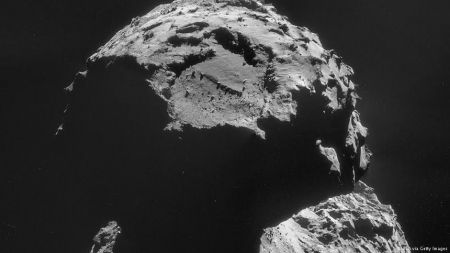Data streams in from wasting Comet Chury

After the resounding success of the Rosetta mission, scientists continue analyzing data sent from comet Chury. Beyond discoveries about the origin of water on Earth, the structure of the comet has now come into focus.
"There's so much we still don't know," says Holger Sierks of the Max Planck Institute for Solar System Research. "Our mission was supposed to provide answers – but every time I look at the photos, I have new questions."
Sierks is sitting in front of a massive screen in an otherwise bare conference room at the institute in Munich, gazing at the most recent photos of Comet 67P/Churyumov-Gerasimenko – otherwise known as Chury. The scientific director of the OSIRIS project – the camera on the Rosetta craft that orbited the comet – Sierks ponders the riddles of the garage-sized stones before him.
"Why does the comet have such an unusual shape? Did it come to exist when two objects joined together? Or did it lose mass around its 'throat' during its journey around the sun?"
Holger Sierks: Where is Philae?
Sierks wishes he had sharper photos. Rosetta has already delivered very informative images from the surface of the comet, some 500 million kilometers (301 million miles) away. Some of the mission's results will be published in the upcoming issue of "Science." For example, regarding the origins of the 50- to 300-meter-deep craters that pock the surface of the comet: They're formed through release of dust and gases.
Through these and other breaches in the comet's surface, Chury loses 700 tons of material daily to outer space. Water vapor, carbon dioxide, carbon monoxide and dust particles – including some several centimeter in diameter – are among the lost materials.
Scientists are therefore theorizing that the interior of the comet must be crisscrossed with small fissures, allowing for release of the material. This explains the comet's low density: just half as much as water.
Tearing apart
Aside from this, Sierks and his colleagues discovered a massive rift across the portion of the comet that connects its two main sections. "It seems there's stress between the two joined spheres," Sierks says, explaining that the crack lies near the comet's rotational axis.
"The rift is quite deep – if you were to stand at its edge, you could fall in," Sierks says. "At some point, this comet will likely tear apart."
Rosetta image of Comet 67P/Churyumov-Gerasimenko (Photo: ESA)
The craters on Chury are likely a result of the comet losing material
And it's also in this region that a particularly large amount of material is stripping away. On photos taken by the probe, fountains of dust can be seen there.
The rubber-ducky-shaped comet's throat, in particular, has posed many riddles for scientists. Some believe the comet could have acquired its unique form when two separate objects collided.
Others believe that earlier it was far more compact and then lost large amounts of material in the thinner regions. The dust fountains seem to support this theory. Sierks notes there are no indications that the two pieces are highly distinct.
Philae's whereabouts still unknown
Apart from continuing to analyze the data, there's still the task of locating the lander Philae, which remains inactive somewhere on the comet's surface.
Sierks had hoped that images from Rosetta delivered shortly before Christmas would help. The conditions had been good: a close orbit, flyover of the landing area with full sunlight. But the resolution was still not high enough.
Yet to orbit any closer than 20 kilometers would be dangerous, especially as the comet becomes more active. Dust and gas emissions could throw Rosetta out of orbit – or damage the craft.
Water on Earth
In Bern, Switzerland, the ROSINA research team caused a scientific sensation in their analysis of molecules from the comet's surface, which they performed using a mass spectrometer.
Urs Mall: Rosetta's data
In December, the researchers found evidence that water on Earth most likely did not stem from comets, as had previously been theorized. This was based on conclusions about the composition of water from the comet, which holds three times as much heavy water as that on Earth.
Heavy water contains a larger amount of the hydrogen isotope deuterium, rather than the hydrogen-1 isotope that makes up most of the hydrogen in water on Earth. It is called "heavy" water because deuterium has twice as much atomic mass as regular hydrogen.
Further discoveries to come
Now, the mass spectrometer has delivered results on the tail of the comet. As it turns out, it's made up of water vapor, carbon dioxide and carbon monoxide. And, the colder the surface, the more carbon dioxide is being lost.
"The composition and amount of gas coming out varies based on sun exposure and area of the comet's surface being examined," says Urs Mall, a ROSINA researcher.
There are seven total articles relating to comet Chury in the current issue of Science. With Rosetta's and Philae's 20 total instruments, new results are surely still to come.
An acoustic sounding of the comet floor from the SESAME instrument system involves such a large volume of data that it will still be some time before analysis can be completed, says researcher Klaus Seidensticker.
And if Philae wakes up due to increased solar exposure as the comet nears the sun in May or June, new experiments could be possible.
 KOHA JONË SONDAZH
KOHA JONË SONDAZH





















